


In Figure 3 we present greyscale maps
corresponding to the R-band and to continuum-subtracted
H images obtained for the
114 galaxies in our sample. A blow-up of the nuclear region is also
shown in the upper right-hand corner of each image, rescaled in
intensity to emphasize details. The size of the compass shown in each
of the images is 0.5 kpc at the distance of the corresponding
galaxy. The average limiting surface brightness of the main images
(3
images obtained for the
114 galaxies in our sample. A blow-up of the nuclear region is also
shown in the upper right-hand corner of each image, rescaled in
intensity to emphasize details. The size of the compass shown in each
of the images is 0.5 kpc at the distance of the corresponding
galaxy. The average limiting surface brightness of the main images
(3 ) are 24.6
mag arcsec-2, 24.3 mag arcsec-2,
and 7 × 10-17 ergs-1 cm-2
arcsec-2 for B, R, and
H
) are 24.6
mag arcsec-2, 24.3 mag arcsec-2,
and 7 × 10-17 ergs-1 cm-2
arcsec-2 for B, R, and
H , respectively.
, respectively.
 |
Figure 3. R (left) and
continuum-subtracted H |
 |
Figure 3. R and continuum-subtracted
H |
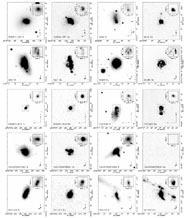 |
Figure 3. R and continuum-subtracted
H |
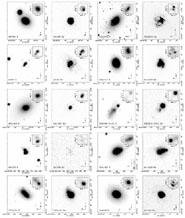 |
Figure 3. R and continuum-subtracted
H |
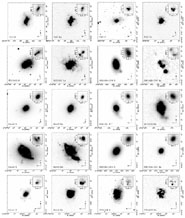 |
Figure 3. R and continuum-subtracted
H |
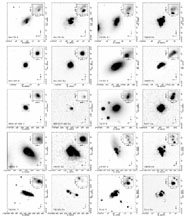 |
Figure 3. R and continuum-subtracted
H |
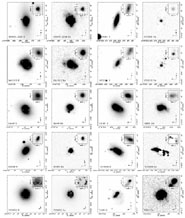 |
Figure 3. R and continuum-subtracted
H |
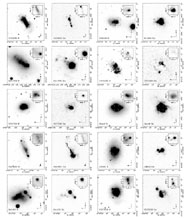 |
Figure 3. R and continuum-subtracted
H |
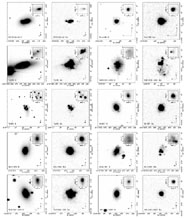 |
Figure 3. R and continuum-subtracted
H |
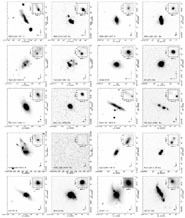 |
Figure 3. R and continuum-subtracted
H |
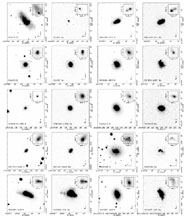 |
Figure 3. R and continuum-subtracted
H |
 |
Figure 3. R and continuum-subtracted
H |
Within the galaxy sample studied only three galaxies were not detected
by us in H emission,
namely Mrk 709,
UCM 1446+2312, and
UGC 4703 NOTES02.
In the case of Mrk 709 the galaxy recession velocity
provided by NED (1,197 km s-1), which was taken from the
21 cm-line velocity data published by
van Zee, Haynes, &
Giovanelli (1995),
differs significantly from that published by
Terlevich et al. (1991)
(~ 15,000 km s-1) and recently confirmed by
E. Pérez-Montero (private communication). This leads us to
suggest that the low-redshift HI emission detected by
van Zee et al. (1995)
is not related to
Mrk 709, but maybe with another object in the
beam that, according to our data, does not show significant ionized
gas emission. For UCM 1446+2312 the uncertainty in the recession
velocity (determined from the position of the
H
emission,
namely Mrk 709,
UCM 1446+2312, and
UGC 4703 NOTES02.
In the case of Mrk 709 the galaxy recession velocity
provided by NED (1,197 km s-1), which was taken from the
21 cm-line velocity data published by
van Zee, Haynes, &
Giovanelli (1995),
differs significantly from that published by
Terlevich et al. (1991)
(~ 15,000 km s-1) and recently confirmed by
E. Pérez-Montero (private communication). This leads us to
suggest that the low-redshift HI emission detected by
van Zee et al. (1995)
is not related to
Mrk 709, but maybe with another object in the
beam that, according to our data, does not show significant ionized
gas emission. For UCM 1446+2312 the uncertainty in the recession
velocity (determined from the position of the
H line in
objective-prism photographic plates;
Alonso et al. 1999)
is ~ ± 1,200 km s-1. Therefore, the line-emission arising
from this object might well be beyond the wavelength region covered by
the 20Å-wide filter used. Finally, UGC 4703 NOTES02 forms with
UGC 4703 NOTES01 an interacting pair where only the
latter shows
H
line in
objective-prism photographic plates;
Alonso et al. 1999)
is ~ ± 1,200 km s-1. Therefore, the line-emission arising
from this object might well be beyond the wavelength region covered by
the 20Å-wide filter used. Finally, UGC 4703 NOTES02 forms with
UGC 4703 NOTES01 an interacting pair where only the
latter shows
H emission. This
suggests that UGC 4703 NOTES02 may have
either exhausted most of its gas early during its evolution, or it may
have lost it as consequence of the interaction with
UGC 4703 NOTES01. Is it important to note that, as
already pointed out
by Cairós et
al. (2001a)
and we have discussed in
Section 3, most of the BCD galaxies were
originally identified by their high surface brightness and blue optical
colors. Therefore, some of them may be expected to show very low
H
emission. This
suggests that UGC 4703 NOTES02 may have
either exhausted most of its gas early during its evolution, or it may
have lost it as consequence of the interaction with
UGC 4703 NOTES01. Is it important to note that, as
already pointed out
by Cairós et
al. (2001a)
and we have discussed in
Section 3, most of the BCD galaxies were
originally identified by their high surface brightness and blue optical
colors. Therefore, some of them may be expected to show very low
H equivalent widths (EW)
(i.e. they are BCDs but they should
not be then classified as HII galaxies). Some examples of this may be
Mrk 1423 and
I Zw 115 (see Section 8).
equivalent widths (EW)
(i.e. they are BCDs but they should
not be then classified as HII galaxies). Some examples of this may be
Mrk 1423 and
I Zw 115 (see Section 8).
The maps presented in Figure 3 show that most of the
galaxies in our sample have an extended, low-surface-brightness halo
visible in the continuum images. Such halos, commonly associated with
an evolved stellar population
(Papaderos et al. 1996;
Cairós et al. 2001a,
b
and references therein), are usually more extended than
the region showing H emission, except perhaps in the case of the most compact objects
(I Zw 18,
HS 0822+3542,
Pox 186). In Paper II
we analyze the structural properties of this low-surface brightness
component. With regard to the morphology in
H
emission, except perhaps in the case of the most compact objects
(I Zw 18,
HS 0822+3542,
Pox 186). In Paper II
we analyze the structural properties of this low-surface brightness
component. With regard to the morphology in
H the inspection
of our images show that 83 galaxies in our sample (73%) show star
formation activity distributed over more than one region. In
particular, in 45 galaxies (39%) we are able to distinguish 4 regions
or more. Only 28 galaxies show their morphology in the light of
H
the inspection
of our images show that 83 galaxies in our sample (73%) show star
formation activity distributed over more than one region. In
particular, in 45 galaxies (39%) we are able to distinguish 4 regions
or more. Only 28 galaxies show their morphology in the light of
H to be dominated by
only a single, nuclear HII region. It is
worth noting that the median distance and seeing for those galaxies
showing only one single star-forming region are 23 Mpc and
1.4 arcsec respectively, while the galaxies with multiple regions are
typically at 19 Mpc and have 1.5 arcsec seeing. Clearly, the
difference between these values is not large enough to explain the
different number of regions detected purely in terms of a differing
spatial resolution.
to be dominated by
only a single, nuclear HII region. It is
worth noting that the median distance and seeing for those galaxies
showing only one single star-forming region are 23 Mpc and
1.4 arcsec respectively, while the galaxies with multiple regions are
typically at 19 Mpc and have 1.5 arcsec seeing. Clearly, the
difference between these values is not large enough to explain the
different number of regions detected purely in terms of a differing
spatial resolution.
Based only on broad-band optical imaging data, Loose & Thuan (1986) undertook a morphological classification of BCD galaxies. They defined four different groups:
The classification of a galaxy as nE or iE BCD is been mainly
determined by the shape of the inner isophotes: regular in the case of
nE, and irregular for the iE BCDs. However, the greyscale maps
presented in Figure 3 show that, in some cases,
despite the continuum isophotes in the inner region being regular, the
H images may show a complex structure composed of several individual HII
regions. An example of this behavior is seen in Mrk 409, where the
inner R-band isophotes are regular (which would lead one to classify
this galaxy as a nE BCD), but the
H
images may show a complex structure composed of several individual HII
regions. An example of this behavior is seen in Mrk 409, where the
inner R-band isophotes are regular (which would lead one to classify
this galaxy as a nE BCD), but the
H emission shows the
presence of a ring composed of at least 5 HII regions (see
Figure 3). In cases like that of Mrk 409 we
have made use of the information provided by the
H
emission shows the
presence of a ring composed of at least 5 HII regions (see
Figure 3). In cases like that of Mrk 409 we
have made use of the information provided by the
H images, and the galaxies
have been reclassified as iE BCDs. The presence of a ring of
star-forming regions around the nucleus of the galaxy has been
observed in a total of 4 objects in our sample including Mrk 409,
namely Mrk 86 (see
Gil de Paz et al. 2000b,
c;
2002),
Mrk 400,
Mrk 409, and VCC 0655. The radius of this ring ranges from 0.5 to
1.0 kpc. In these cases we have added a letter `r' to the
morphological type of the objects.
images, and the galaxies
have been reclassified as iE BCDs. The presence of a ring of
star-forming regions around the nucleus of the galaxy has been
observed in a total of 4 objects in our sample including Mrk 409,
namely Mrk 86 (see
Gil de Paz et al. 2000b,
c;
2002),
Mrk 400,
Mrk 409, and VCC 0655. The radius of this ring ranges from 0.5 to
1.0 kpc. In these cases we have added a letter `r' to the
morphological type of the objects.
The results of the morphological classification are given in
Table 5. For the objects with detected
H emission
27 out of 111 (24%) were classified as nE BCDs, 37 (33%) as iE, and
39 (35%) as iI. For the 39 iI BCDs, 11 are "cometary" (iI,C) and 10
are "mergers" (iI,M). In only 8 galaxies did we not detect any
underlying/extended R-band continuum light (that would be otherwise
be associated with an old stellar population) and, consequently, they
were classified as i0 BCDs. Within this group are the objects with the
lowest metallicity in our sample
(I Zw 18,
Tol 65,
UCM 1612+1308). For
comparison, within their sample of 28 BCDs,
Cairós et al. (2001a,
b)
found 21% of nE, 39% of iE, and 32% of iI BCDs (7% and
14% of the total were iI,C and iI,M BCDs, respectively).
emission
27 out of 111 (24%) were classified as nE BCDs, 37 (33%) as iE, and
39 (35%) as iI. For the 39 iI BCDs, 11 are "cometary" (iI,C) and 10
are "mergers" (iI,M). In only 8 galaxies did we not detect any
underlying/extended R-band continuum light (that would be otherwise
be associated with an old stellar population) and, consequently, they
were classified as i0 BCDs. Within this group are the objects with the
lowest metallicity in our sample
(I Zw 18,
Tol 65,
UCM 1612+1308). For
comparison, within their sample of 28 BCDs,
Cairós et al. (2001a,
b)
found 21% of nE, 39% of iE, and 32% of iI BCDs (7% and
14% of the total were iI,C and iI,M BCDs, respectively).
| Object Name | B | R | B-R |
fH |
MB | log
LH |
T |
EWH |
| (mag) | (mag) | (mag) | (10-14 erg/s/cm2) | (mag) | (erg/s) | (Å) | ||
| (1) | (2) | (3) | (4) | (5) | (6) | (7) | (8) | (9) |
| IC 10 | 5.75±0.03 | 5.45±0.08 | 0.30±0.08 | 51000±3700 | -19.25 | 40.79 | iI,C | 36 |
| HS 0029+1748 | 16.74±0.05 | 15.93±0.14 | 0.81±0.15 | 19.1±2.5 | -15.87 | 40.40 | nE | 228 |
| Haro 14 | 13.65±0.05 | 12.91±0.14 | 0.74±0.15 | 34±4 | -17.08 | 39.90 | iE | 22 |
| UM 285 | 17.00±0.03 | 17.03±0.08 | -0.02±0.08 | 5.8±0.4 | -15.25 | 39.74 | iI,C | 187 |
| UCM 0049-0045 | 14.76±0.04 | 13.36±0.25 | 1.39±0.25 | 20±4 | -17.18 | 40.14 | iE | 20 |
| UM 323 | 16.09±0.04 | 15.24±0.08 | 0.85±0.09 | 14.1±1.2 | -16.17 | 40.13 | iE | 83 |
| Mrk 996 | 15.01±0.03 | 14.08±0.14 | 0.93±0.14 | 54±7 | -16.87 | 40.56 | nE | 109 |
| UM 133 | 15.41±0.03 | 14.51±0.14 | 0.90±0.14 | 20±3 | -16.50 | 40.15 | iI,C | 60 |
| UM 382 | 18.20±0.04 | 17.83±0.22 | 0.37±0.22 | 2.6±0.5 | -15.33 | 39.90 | iI,C | 170 |
| UM 404 | 18.48±0.05 | 18.40±0.12 | 0.08±0.13 | 3.6±0.4 | -15.09 | 40.06 | i0 | 455 |
| KUG 0207-016A | 15.24±0.05 | 14.77±0.12 | 0.47±0.13 | 14.3±1.5 | -18.28 | 40.64 | iI | 54 |
| UM 408 | 17.46±0.16 | 16.70±0.12 | 0.75±0.20 | 6.8±0.8 | -16.12 | 40.34 | nE | 161 |
| UM 417 | 18.37±0.07 | 17.73±0.13 | 0.64±0.15 | 4.4±0.5 | -14.58 | 39.90 | iI,C | 279 |
| Mrk 370 | 13.49±0.03 | 12.21±0.12 | 1.28±0.13 | 70±7 | -16.94 | 40.10 | iE | 24 |
| Mrk 600 | 14.85±0.03 | 14.82±0.15 | 0.03±0.15 | 24±3 | -15.97 | 39.78 | iE | 96 |
| NGC 1522 | 14.03±0.01 | 13.22±0.06 | 0.81±0.06 | 59.9±0.6 | -16.10 | 39.91 | iE | 54 |
| NGC 1705 | 13.09±0.01 | 12.19±0.06 | 0.90±0.06 | 253±3 | -15.45 | 39.90 | iE | 90 |
| II Zw 33 | 14.21±0.03 | 13.34±0.11 | 0.86±0.11 | 93±9 | -18.77 | 41.24 | iI | 95 |
| II Zw 33B | 16.87±0.04 | 15.67±0.11 | 1.21±0.12 | 5.1±0.5 | -16.12 | 39.98 | iI | 43 |
| II Zw 40 | 11.87±0.04 | 11.10±0.09 | 0.77±0.09 | 1554±120 | -18.09 | 41.25 | iI,M | 217 |
| Tol 0610-387 | 15.90±0.05 | 14.87±0.06 | 1.03±0.08 | 16±1 | -15.89 | 40.01 | iE | 68 |
| Mrk 005 | 15.13±0.04 | 14.56±0.13 | 0.57±0.13 | 28±3 | -15.47 | 39.77 | iI,C | 89 |
| Mrk 007 | 14.29±0.03 | 13.49±0.18 | 0.79±0.18 | 36±6 | -19.00 | 40.95 | iI | 41 |
| Mrk 86 | 12.07±0.03 | 11.49±0.11 | 0.58±0.11 | 241±23 | -17.13 | 40.14 | iE,r | 44 |
| HS 0822+3542 | 17.85±0.03 | 17.76±0.14 | 0.09±0.14 | 7.4±0.9 | -12.18 | 38.95 | iI,C | 546 |
| UGC 4483 | 15.14±0.03 | 14.56±0.13 | 0.58±0.13 | 36±4 | -12.38 | 38.64 | iI,C | 115 |
| UGC 4703N1 | 15.86±0.04 | 15.01±0.03 | 0.85±0.05 | 24.9±0.5 | -17.58 | 40.85 | iI,M | 120 |
| UGC 4703N2 | 17.04±0.04 | 16.10±0.03 | 0.94±0.05 | ... | -16.39 | ... | ... | ... |
| Mrk 1416 | 16.32±0.03 | 15.75±0.02 | 0.58±0.04 | 19.4±0.8 | -16.32 | 40.42 | iI | 191 |
| Mrk 108 | 15.15±0.03 | 14.66±0.08 | 0.49±0.08 | 73±5 | -16.54 | 40.62 | iI,M | 275 |
| Mrk 400 | 14.30±0.04 | 13.63±0.11 | 0.67±0.12 | 39±4 | -18.41 | 40.76 | iE,r | 51 |
| NGC 2915 | 11.93±0.01 | 10.96±0.06 | 0.97±0.06 | 209±3 | -15.85 | 39.51 | iE | 23 |
| I Zw 18 | 16.05±0.04 | 16.24±0.07 | -0.18±0.08 | 35.2±2.4 | -14.45 | 39.83 | i0 | 679 |
| Mrk 1418 | 13.86±0.03 | 12.61±0.19 | 1.25±0.20 | 95±16 | -16.42 | 40.17 | iE | 49 |
| Mrk 1423 | 14.90±0.03 | 13.52±0.10 | 1.38±0.11 | 6.8±0.4 | -16.65 | 39.53 | nE | 8 |
| SBS 0940+544C | 17.18±0.04 | 17.05±0.10 | 0.13±0.11 | 5.1±0.5 | -14.73 | 39.55 | iI,M | 165 |
| Mrk 709 | 16.32±0.03 | 15.65±0.02 | 0.67±0.04 | ... | -14.66 | ... | ... | ... |
| Mrk 1426 | 15.88±0.04 | 15.44±0.12 | 0.44±0.12 | 7.8±0.8 | -16.24 | 39.82 | iE | 55 |
| UGCA 184 | 15.99±0.04 | 15.80±0.10 | 0.19±0.11 | 14.0±1.4 | -15.82 | 39.95 | iI | 142 |
| Mrk 409 | 14.37±0.03 | 13.33±0.05 | 1.04±0.06 | 29.2±1.7 | -17.27 | 40.20 | iE,r | 29 |
| Tol 001 | 15.74±0.05 | 15.48±0.07 | 0.26±0.09 | 12.0±0.9 | -16.09 | 39.89 | iE | 88 |
| Tol 002 | 14.06±0.01 | 13.34±0.06 | 0.72±0.06 | 121.3±1.8 | -15.19 | 39.86 | iE | 127 |
| NGC 3125 | 13.05±0.01 | 12.25±0.06 | 0.80±0.06 | 342±4 | -16.79 | 40.55 | iE | 131 |
| SBS 1006+578 | 16.42±0.04 | 15.78±0.11 | 0.64±0.12 | 5.6±0.6 | -15.34 | 39.53 | iE | 53 |
| Haro 2 | 13.39±0.04 | 12.87±0.11 | 0.52±0.11 | 157±16 | -18.28 | 40.94 | nE | 105 |
| Mrk 1434 | 16.77±0.04 | 16.43±0.13 | 0.33±0.14 | 16.4±2.0 | -15.85 | 40.34 | i0 | 324 |
| Haro 3 | 13.22±0.04 | 12.61±0.13 | 0.61±0.14 | 275±30 | -17.57 | 40.83 | iE | 148 |
| SBS 1054+504 | 16.08±0.04 | 15.46±0.15 | 0.62±0.15 | 4.3±0.5 | -15.44 | 39.32 | nE | 30 |
| Haro 4 | 15.59±0.04 | 15.44±0.17 | 0.15±0.17 | 66±12 | -14.14 | 39.79 | iI | 589 |
| VII Zw 403 | 14.11±0.04 | 13.58±0.11 | 0.53±0.12 | 59±6 | -14.30 | 39.21 | iE | 75 |
| Mrk 178 | 14.15±0.04 | 13.60±0.09 | 0.55±0.10 | 109±9 | -13.96 | 39.36 | iI,M | 146 |
| UM 439 | 14.77±0.03 | 14.09±0.06 | 0.67±0.07 | 42.8±2.5 | -15.96 | 40.00 | iE | 88 |
| Mrk 1450 | 15.75±0.05 | 15.09±0.09 | 0.67±0.10 | 42±4 | -15.08 | 40.04 | nE | 234 |
| UM 452 | 15.25±0.03 | 14.07±0.11 | 1.19±0.12 | 4.7±0.5 | -16.20 | 39.33 | nE | 9 |
| SBS 1147+520 | 16.95±0.05 | 15.98±0.09 | 0.97±0.10 | 1.4±0.2 | -14.44 | 38.78 | nE | 16 |
| Tol 17 | 15.99±0.05 | 15.05±0.06 | 0.94±0.08 | 17.5±1.0 | -16.20 | 40.20 | iE | 86 |
| UM 455 | 17.02±0.03 | 16.26±0.01 | 0.77±0.03 | 6.9±0.3 | -16.62 | 40.38 | iI | 105 |
| UM 456 | 15.37±0.03 | 14.66±0.01 | 0.71±0.03 | 24.5±0.9 | -16.48 | 40.21 | iI | 85 |
| UM 456A | 16.71±0.03 | 16.05±0.01 | 0.66±0.03 | 4.20±0.16 | -15.24 | 39.48 | iI | 51 |
| Pox 4 | 15.27±0.04 | 14.88±0.10 | 0.38±0.11 | 94±9 | -18.18 | 41.43 | iI,M | 478 |
| ESO 572-G025 | 15.02±0.04 | 14.07±0.03 | 0.94±0.05 | 60.6±1.6 | -16.80 | 40.59 | nE | 125 |
| VCC 0001 | 15.80±0.03 | 14.42±0.01 | 1.37±0.04 | 1.90±0.06 | -15.22 | 38.77 | nE | 5 |
| Mrk 1313 | 16.02±0.03 | 15.50±0.06 | 0.52±0.06 | 8.6±0.5 | -16.49 | 40.02 | i0 | 64 |
| VCC 0130 | 17.05±0.05 | 16.27±0.01 | 0.78±0.05 | 1.75±0.06 | -13.97 | 38.73 | iE | 26 |
| Haro 8 | 14.27±0.03 | 13.20±0.11 | 1.07±0.11 | 43±4 | -16.75 | 40.12 | nE | 38 |
| UM 491 | 15.54±0.03 | 14.95±0.07 | 0.59±0.08 | 8.8±0.6 | -16.66 | 39.90 | nE | 39 |
| ISZ 399 | 14.18±0.01 | 12.99±0.06 | 1.19±0.06 | 41.8±2.4 | -15.99 | 39.77 | nE | 30 |
| VCC 0459 | 14.95±0.05 | 14.13±0.01 | 0.83±0.05 | 20.4±0.5 | -16.07 | 39.80 | iI | 42 |
| VCC 0655 | 13.32±0.04 | 12.12±0.03 | 1.20±0.05 | 75.1±2.2 | -17.70 | 40.36 | iE,r | 24 |
| Tol 65 | 17.26±0.04 | 16.84±0.03 | 0.42±0.05 | 24.9±1.0 | -15.52 | 40.59 | i0 | 916 |
| VCC 0848 | 15.03±0.05 | 14.10±0.01 | 0.93±0.05 | 14.2±0.4 | -15.99 | 39.64 | iI,M | 28 |
| Mrk 209 | 14.15±0.03 | 13.94±0.13 | 0.21±0.13 | 173±20 | -14.67 | 39.84 | iE | 349 |
| Mrk 1329 | 14.08±0.03 | 13.38±0.09 | 0.70±0.10 | 67±6 | -16.94 | 40.31 | iI,C | 70 |
| UGCA 290 | 15.67±0.03 | 15.04±0.13 | 0.63±0.13 | 6.2±0.9 | -13.46 | 38.52 | iI,M | 29 |
| VCC 1750 | 16.73±0.03 | 15.93±0.05 | 0.80±0.06 | 3.8±0.2 | -14.29 | 39.06 | iI | 41 |
| Haro 9 | 13.02±0.05 | 12.24±0.10 | 0.78±0.11 | 221±21 | -17.91 | 40.79 | nE | 82 |
| NGC 4861 | 12.68±0.03 | 11.91±0.09 | 0.76±0.09 | 560±5 | -17.82 | 41.03 | iI,C | 160 |
| UM 533 | 14.63±0.04 | 13.64±0.11 | 0.99±0.11 | 31±3 | -15.71 | 39.71 | iE | 41 |
| Mrk 450 | 14.44±0.05 | 13.65±0.10 | 0.79±0.11 | 11.8±1.1 | -16.13 | 39.38 | iE | 15 |
| NGC 5058 | 14.05±0.03 | 13.37±0.07 | 0.68±0.08 | 45±3 | -16.58 | 39.99 | iI | 47 |
| PGC 046448 | 15.47±0.03 | 14.51±0.01 | 0.96±0.03 | 8.9±0.4 | -17.48 | 40.21 | iE | 26 |
| Pox 186 | 17.73±0.03 | 17.39±0.01 | 0.35±0.04 | 14.8±0.5 | -13.20 | 39.62 | i0 | 907 |
| Tol 35 | 14.17±0.03 | 13.22±0.05 | 0.94±0.06 | 83±4 | -17.99 | 40.86 | iE | 76 |
| SBS 1331+493 | 14.87±0.03 | 14.16±0.17 | 0.71±0.17 | 25±4 | -15.11 | 39.47 | iE | 54 |
| Tol 85 | 16.51±0.03 | 15.99±0.01 | 0.52±0.03 | 20.5±0.9 | -16.96 | 40.78 | iI | 261 |
| Mrk 67 | 16.10±0.03 | 15.34±0.08 | 0.76±0.09 | 25.1±2.0 | -14.67 | 39.79 | nE | 170 |
| Mrk 1480 | 16.17±0.03 | 15.56±0.08 | 0.61±0.08 | 13.9±1.0 | -16.01 | 40.09 | nE | 111 |
| Mrk 1481 | 16.19±0.03 | 15.57±0.06 | 0.62±0.07 | 4.4±0.3 | -15.99 | 39.60 | iI,M | 34 |
| Tol 1345-420 | 15.87±0.03 | 15.00±0.03 | 0.87±0.05 | 33.5±1.1 | -16.67 | 40.62 | nE | 165 |
| HS 1400+3927 | 17.04±0.05 | 15.94±0.10 | 1.10±0.12 | 8.6±0.8 | -14.58 | 39.66 | nE | 97 |
| SBS 1415+437 | 15.43±0.03 | 14.77±0.12 | 0.66±0.13 | 50±6 | -14.59 | 39.79 | iI,C | 203 |
| SBS 1428+457 | 15.42±0.05 | 14.67±0.09 | 0.75±0.10 | 48±4 | -17.32 | 40.85 | iI | 173 |
| Tol 1434+032 | 15.86±0.03 | 15.42±0.06 | 0.44±0.07 | 11.3±0.7 | -15.80 | 39.79 | iI | 78 |
| Mrk 475 | 16.20±0.03 | 15.67±0.07 | 0.53±0.08 | 35.6±2.4 | -13.73 | 39.60 | nE | 355 |
| HS 1440+4302 | 17.58±0.05 | 16.54±0.11 | 1.04±0.12 | 4.1±0.4 | -15.32 | 39.85 | nE | 80 |
| HS 1442+4250 | 15.55±0.05 | 15.01±0.07 | 0.54±0.09 | 14.7±1.1 | -14.90 | 39.42 | iE | 69 |
| UCM 1446+2312 | 15.77±0.03 | 14.52±0.09 | 1.25±0.10 | ... | -16.96 | ... | ... | ... |
| Tol 1448+116 | 16.15±0.05 | 15.95±0.10 | 0.21±0.12 | 8.9±0.9 | -16.02 | 39.90 | iE | 101 |
| II Zw 70 | 14.84±0.12 | 14.29±0.13 | 0.55±0.18 | 83±11 | -16.52 | 40.54 | iI | 217 |
| II Zw 71 | 14.45±0.15 | 13.54±0.12 | 0.91±0.19 | 40±4 | -16.91 | 40.23 | iI | 49 |
| I Zw 115 | 15.04±0.09 | 14.14±0.08 | 0.91±0.12 | 1.88±0.16 | -15.24 | 38.47 | iE | 4 |
| SBS 1533+574 | 16.02±0.10 | 15.30±0.10 | 0.72±0.14 | 30±3 | -17.46 | 40.95 | iE | 198 |
| I Zw 123 | 15.42±0.10 | 14.85±0.08 | 0.57±0.13 | 35±3 | -14.92 | 39.76 | nE | 151 |
| HS 1609+4827 | 15.11±0.11 | 14.55±0.09 | 0.56±0.14 | 20.9±1.8 | -18.04 | 40.66 | nE | 64 |
| UCM 1612+1308 | 17.21±0.14 | 17.31±0.07 | -0.10±0.15 | 7.1±0.5 | -16.42 | 40.38 | i0 | 313 |
| UGCA 412 | 15.55±0.05 | 14.62±0.09 | 0.92±0.11 | 35±3 | -17.52 | 40.85 | nE | 120 |
| HS 1704+4332 | 18.41±0.03 | 17.87±0.08 | 0.54±0.09 | 3.3±0.3 | -14.13 | 39.61 | i0 | 236 |
| NGC 6789 | 13.74±0.03 | 12.69±0.07 | 1.05±0.08 | 32.7±2.0 | -14.04 | 38.70 | iE | 18 |
| Tol 1924-416 | 13.97±0.04 | 13.50±0.03 | 0.47±0.05 | 297±5 | -19.09 | 41.78 | iE | 413 |
| Tol 1937-423 | 15.14±0.04 | 14.25±0.03 | 0.89±0.05 | 21.7±0.4 | -17.96 | 40.66 | iE | 50 |
| Mrk 900 | 14.17±0.03 | 13.56±0.12 | 0.61±0.13 | 55±6 | -17.20 | 40.37 | nE | 68 |
| Mrk 314 | 13.55±0.03 | 13.12±0.24 | 0.43±0.24 | 64±13 | -18.99 | 40.90 | iI,M | 53 |
| Mrk 324 | 15.17±0.03 | 14.60±0.13 | 0.57±0.14 | 16.0±1.9 | -16.84 | 40.09 | nE | 51 |
| Mrk 328 | 14.93±0.05 | 14.18±0.09 | 0.74±0.10 | 17.4±1.4 | -16.82 | 40.02 | nE | 38 |
Note. - Columns stand for: (1) Galaxy
name (2) B-band integrated magnitude and its
1- |
||||||||
It is worth mentioning that, although the fraction of BCDs with elliptical envelopes is < 60 per cent, the four galaxies where a ring of star-forming regions was found are all iE BCDs. This fact suggests that the shaping of these rings requires a highly symmetric distribution of the galaxy stellar and total mass.